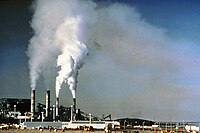
Photo from wikipedia
Wastewater from a limestone-gypsum wet desulfurization system cannot be directly reused or discharged due to its high suspended matter content and complex water composition. Desulfurization wastewater evaporation in flue gas… Click to show full abstract
Wastewater from a limestone-gypsum wet desulfurization system cannot be directly reused or discharged due to its high suspended matter content and complex water composition. Desulfurization wastewater evaporation in flue gas is an effective way to dispose wastewater. Multicomponent soluble chlorine salts exist in the desulfurization wastewater. During the evaporation, chlorine enters into the flue gas due to volatilization, which accelerates the enrichment rate of the Cl− concentration in the desulfurization slurry and leads to an increase in wastewater production. This study explored the chlorine migration of various chlorine salt solutions and typical desulfurization wastewater at high temperature during the evaporation process of concentrated wastewater by a laboratory-scale tube furnace and a pilot-scale system. Results showed that when NaCl-evaporated substance was heated, the chlorine ion hardly volatilized. For the evaporated substances of CaCl2 and MgCl2 solutions, some of the crystal water was lost, and hydrolysis occurred to generate gaseous HCl. NH4Cl was easily sublimed, and the decomposition temperature was lowest. A pilot study on spray evaporation of desulfurization wastewater in flue gas showed that the particle size of the evaporated product increased and the main particle size was within 2.5–10 μm with increasing flue gas temperature. Increasing the mass ratio of gas to liquid significantly reduced the particle size of the atomized particles, thereby reducing the average particle size of the evaporated particles. The HCl concentration increased with increasing flue gas temperature. When the flue gas temperature was 350 °C, the concentration of HCl was 40 ppm, and the escape rate of chlorine in the desulfurization wastewater was approximately 30% using typical wastewater from a limestone-gypsum wet desulfurization system.
Journal Title: Environmental Science and Pollution Research
Year Published: 2018
Link to full text (if available)
Share on Social Media: Sign Up to like & get
recommendations!